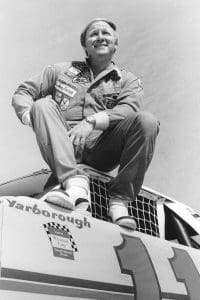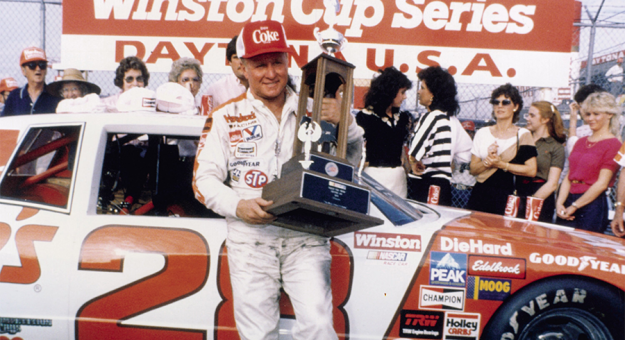INDIANAPOLIS — There was never anything quiet about the way Cale Yarborough went racing. Win, lose or crash, everyone knew he was there.
The harder the fight, the tougher he was. I got all of that the first time I saw him, in the 1977 Mason-Dixon 500 at Dover (Del.) Motor Speedway.
Yarborough, who died on the last day of 2023, listed his height as 5-foot-7, which seemed, well, generous. But put a steering wheel in his hands, and Cale stood 10 feet tall.
Long before that Sunday at Dover, I had him perched on a pedestal. He’d been one of a handful of NASCAR racers who in the late ’60s and early ’70s would drift toward Indianapolis to take part in the 500. Bobby and Donnie Allison did that, too, as did LeeRoy Yarbrough, and I loved them for it. Indy was awfully dangerous in those days, but, hell, so were Daytona and Charlotte. Picture a bullfighter using his weekend off to free-climb the Matterhorn.
But you were not going to scare Cale Yarborough. In 1965, he sailed a Banjo Matthews car clear out of Darlington (S.C.) Raceway. It crumpled into a red steel ball as it rolled down a steep embankment. Cale shrugged it off, even managed a brief smile as he walked back to the pits. Live another week, fight another bull.

He ran the Indy 500 four times between 1966 and ’72, in an oddball era at the grand old speedway. The rear-engine revolution was barely complete and now an aerodynamic upheaval was underway. Lots of teams, including those Cale drove for, saw their homemade cars badly outpaced by Lolas, McLarens and Eagles. Truth is, he never had anything close to a top-shelf Indy ride.
Then again, only twice did he have an extended stay in a premier NASCAR seat. He struggled in third-tier Fords while sweeping floors at Holman Moody for an hourly wage of $1.25 and had a short stint with Matthews. His breakthrough came when Ford Motor Co. paired him with Wood Brothers Racing in late 1966. Across the next three seasons, Cale notched 12 Cup Series wins, including both the Daytona 500 and the Southern 500 in 1968.
Then, after a couple of years adrift following Ford’s 1971 departure from NASCAR, Yarborough caught an even bigger break. Junior Johnson and his driver, Bobby Allison, won 10 of the 1972 season’s 31 races, but could not get along. Aboard Junior’s Chevrolets, Cale won 17 times between 1973 and ’75, then bagged 28 more on his way to three straight Cup Series titles from 1976-’78.
Yarborough had immense natural ability. He will be remembered as an oval-track man, but three of his five IROC victories came on road courses. At Riverside in 1977, he outran A.J. Foyt and Jody Scheckter; back there again in ’78, he topped Mario Andretti and Al Unser.
In 1984 at Cleveland’s physically demanding Burke Lakefront Airport circuit, Yarborough nursed a shoulder injury and “a bum leg” that awaited surgery. He wasn’t sure he could go the distance. At the checkered flag, he was nine seconds ahead of five-time Le Mans winner Derek Bell. Not bad, Cale said, “for an old broke-up stock car driver.”
He wanted to race, race, race, until a backyard epiphany in 1980 slowed him down. He saw his daughter sitting on the porch and asked why, on this beautiful day, she wasn’t riding her bicycle.
“My bike is broken,” the girl replied.
“Why didn’t you tell me?”
“Daddy,” she said, “I told you three times.”
Within days, Cale told Johnson that he was no longer interested in running the full Cup Series schedule. You know how things went from there: Darrell Waltrip got the Johnson gig and won the 1981, ’82 and ‘85 Cup Series championships. But Cale did OK: Running the partial schedules he desired, he won 14 times for M.C. Anderson and Harry Ranier, including consecutive Daytona 500s with Ranier in 1983 and ’84.
The 1977 Mason-Dixon 500 at Dover was far less prestigious, but it will stay with me forever. David Pearson led early, but it was soon clear that Yarborough had the best car. Then a scrape in traffic left the rear bumper of his Monte Carlo dangling and he was black flagged.
I’d been writing for less than a year, yet at 16 I’d landed a media credential that gave me the run of the joint. I was standing behind Cale’s pit stall when he came in. A crewman leapt over the wall and grabbed hold of the bumper, which stubbornly clung to the car. Junior Johnson slapped a second crewman on the back. Now there were two of them wrestling with the bumper — and losing.
Junior lost all patience. He clambered over the wall and cleared out both helpers with one sweep of his arm. Crouching, he worked the bumper back and forth, the way you’d try to break a wire. Off it came. Junior threw it aside like trash he was mad at. It was a scene out of a movie.
The stop had taken 30 seconds. Someone shouted for Yarborough to go, and go he did, tearing after Pearson. Then came a second black flag for Cale, this time for a broken rear shock that was dragging on the track. Removing it took two minutes. By now, he was nearly four laps down.
There was nothing left to do but charge. Always, that was the best scenario for Yarborough. He got some help from timely yellow flags and, of course, from Johnson’s strong Chevrolet, but he made up all the ground he’d lost. He caught and passed Pearson for the last time on lap 404 and won by six seconds.
This was the way to see William Caleb Yarborough for the first time. Here he came, 10 feet tall, goaded into a fight and ready to win it. And there he went, holding the trophy.
This story appeared in the Jan 10, 2024 edition of the SPEED SPORT Insider.

